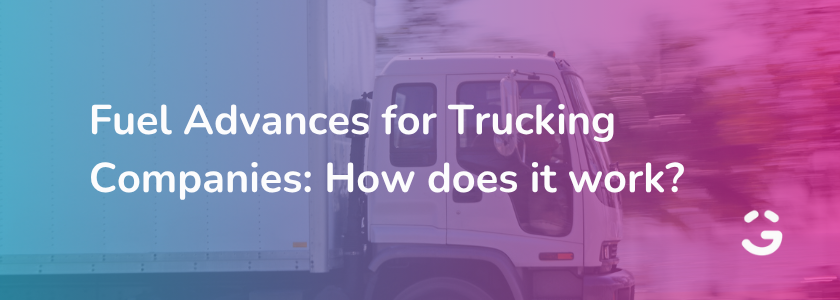Fuel is one of the biggest ongoing expenses for trucking companies, often surpassing maintenance and insurance. And when payments from shippers are delayed, it can be tough to keep your trucks fueled and your routes on schedule.
To bridge that gap, many drivers turn to fuel advances. These short-term funding options give you access to money for fuel before your full invoice is paid. One common approach is fuel advance factoring, where a portion of your load payment is advanced to cover immediate costs like diesel and tolls.
In this guide, we’ll explain how fuel advance trucking works, when it makes sense to use a fuel advance loan for truckers, and how it compares to other solutions—like fuel cards. We’ll also break down the pros and cons of each to help you choose what’s best for your business.
Looking for fast, flexible funding? Explore truck driver loans that keep your business running without delays.
What Is a Fuel Advance for Trucking Businesses?
Fuel is one of the biggest daily costs for truckers and when you’re waiting to get paid, it can quickly strain your cash flow. That’s where a fuel advance for trucking comes in. It’s a short-term funding solution that helps cover fuel, tolls, and other trip-related expenses before you complete a delivery and receive full payment.
Here’s how it works: After confirming a load pickup, a broker or factoring company may offer you an advance—typically a percentage of your expected payout. This gives you immediate access to funds, so you can fuel up and stay on schedule without dipping into personal savings.
Unlike traditional loans, a fuel advance loan for truckers doesn’t require perfect credit or a long approval process. It’s based on your upcoming work, making it a fast, reliable option for covering costs between pickups and drop-offs.
This type of fuel advance trucking solution is especially helpful when fuel prices spike or when payment delays make it hard to stay on the road. It’s all about getting the money you need—when you need it—to keep your business running smoothly.
How Fuel Advances Work
When you’re running your own truck or managing a small fleet, waiting weeks for payment can create serious cash flow issues. Fuel advances for trucking help bridge that gap by giving you a portion of your expected load payment upfront. That way, you can cover fuel and trip expenses without delays.
Here’s how the process usually goes:
Step 1: Book a Load
You accept a load through a broker or direct customer. Once the pickup is confirmed, you become eligible to request a fuel advance.
Step 2: Request the Advance
Most brokers or fuel advance factoring companies offer 40% to 60% of the total load payment in advance. You’ll need to provide documentation such as the rate confirmation and a signed bill of lading.
Step 3: Get Paid
After approval, the fuel advance loan for truckers is deposited directly into your account—often within a few hours. This lets you fill up your tank and cover other immediate trip costs.
Step 4: Final Payment Upon Delivery
Once the delivery is complete and you submit the required paperwork, the remaining balance (minus any fees) is released to you.
Keep in mind that the advance isn’t extra income—it’s early access to money you’ve already earned. Fees and terms vary by provider, and some offer fuel card integrations for added convenience. Knowing how these advances work can help you stay on the road without stressing over fuel costs.
Fuel Advance Factoring vs. Fuel Advance Loan vs. Fuel Card: What’s Better for Drivers?

When it comes to managing fuel costs on the road, two top tools are fuel cards and fuel advance loans for truckers. Both can help you keep rolling without tapping into personal funds, but they work in different ways.
What’s a Fuel Card?
A fuel card is like a credit card, but it’s restricted to fuel purchases. Carriers and owner-operators often get discounts at select stations and access to tracking tools that make fuel management easier.
Pros:
- Discounts at the pump
- Easy to manage receipts and reports
- Helps control spending
Cons:
- Limited to approved fuel stations
- May require good credit
- Can have hidden fees or restrictions
What’s a Fuel Advance Loan?
A fuel advance loan for truckers provides upfront cash based on your expected income, usually tied to a booked load. These loans are offered by non-traditional lenders or gig-friendly platforms, and they’re not always connected to a specific invoice or factoring relationship. You can use the funds for fuel, tolls, repairs, or other trip-related costs.
Pros:
- Cash deposited directly into your account
- Flexible use — not limited to fuel
- Easier approval, especially for 1099 drivers
Cons:
- Small service fees may apply
- May require proof of income or load pickup
- Repayment is usually tied to expected revenue, not a specific invoice
Fuel Advance Factoring
Fuel advance factoring is a factoring-based solution offered by companies that manage your freight invoices. After confirming load pickup, you receive a portion of the invoice amount upfront—typically 40–60%—to cover fuel or trip costs. The remaining balance is paid once delivery is completed and the invoice is processed.
Pros:
- Fast access to cash from trusted factoring partners
- Approval based on your broker/client’s credit
- Built-in support if you're already factoring invoices
Cons:
- Slightly lower total payout due to factoring fees
- May only work within certain broker networks
- Requires paperwork like rate confirmations and bills of lading
Which Option Is Better?
It depends on what your trucking business needs most.
- Fuel cards offer structured spending, fuel discounts, and detailed tracking—making them a great fit for ongoing, predictable expenses.
- Fuel advance loans give you flexible cash upfront and can be used for more than just fuel. They’re helpful when you need fast funding without tying it to a specific invoice.
- Fuel advance factoring works best when you're already working with a factoring company and want cash tied directly to a booked load. It helps cover costs between pickup and final payment.
For many independent drivers and small fleets, combining tools is the smartest move. A fuel card helps manage routine expenses, while fuel advance loans or fuel advance factoring offer fast access to funding when cash is tight and timing matters.
Use what fits your workflow and keep your business rolling no matter what the road throws at you.
Alternatives to Fuel Advances
Fuel advances aren’t the only way to manage rising fuel costs or unpredictable cash flow. Depending on your situation, other flexible funding options might make more sense, especially if you want more control, fewer fees, or funding not tied to a single delivery.
Here are some common alternatives to consider:
Personal Loans
A personal loan gives you a lump sum you can use for anything, such as fuel, repairs, or even emergency expenses. It’s a solid choice if you want flexibility and predictable monthly payments. Some lenders, like Giggle Finance, offer personal loans tailored specifically for truck drivers with 1099 or gig-style income.
Business Advances
A business advance gives you funding based on your expected future revenue. You repay it through small daily or weekly payments. This works well for owner-operators or small fleets with steady loads but cash flow gaps.
Line of Credit
With a business line of credit, you get access to a revolving pool of funds and only pay interest on what you use. It’s ideal for managing fuel costs, tolls, and other recurring expenses without taking out a full loan every time.
Equipment Financing
If your biggest costs are truck repairs, upgrades, or new rigs, equipment financing can be a smarter choice than dipping into fuel cash. You get the gear you need and pay it off over time, keeping your working capital intact.
Still deciding? Truck driver loans through Giggle Finance are fast, flexible, and built for independent drivers—perfect when you need a fuel funding solution without the hassle.
Tips for Managing Fuel Costs as a Trucker
Fuel is one of your biggest operating expenses, but with the right habits, you can cut costs without cutting corners. Here are a few smart ways to keep more money in your pocket:
Use Fuel Discount Programs and Apps
Fuel cards and mobile apps offer discounts at select stations. Tools like Mudflap, GasBuddy, and Trucker Path help you track the lowest fuel prices along your route. Even saving a few cents per gallon adds up over time.
Plan Your Routes Carefully
Avoiding traffic, detours, and excessive idle time can significantly reduce fuel waste. Use route-planning tools to map out the most efficient paths and schedule stops in areas with cheaper fuel.
Drive With Fuel Efficiency in Mind
Small changes in driving habits make a big impact. Ease off the gas, reduce unnecessary idling, and maintain steady speeds. Don’t forget regular maintenance—well-inflated tires and a tuned engine go a long way in boosting fuel economy.
Final Thoughts
There’s no one-size-fits-all solution when it comes to fuel funding. Maybe you need fast cash to cover a long haul. Maybe a fuel card with consistent perks fits better. It all depends on your cash flow, routes, and business goals.
Each driver’s needs are different, and the right option depends on where you are in your journey. If you're looking for something quick, flexible, and built around your schedule, Giggle Finance can help.
Disclaimer: Giggle Finance provides Revenue-Based Financing programs for business purposes only. Any mention of any loan product(s), consumer product(s), or other forms of financing is solely for marketing and educational content purposes and to help distinguish Giggle’s product from other comparable financing options available in the market.
